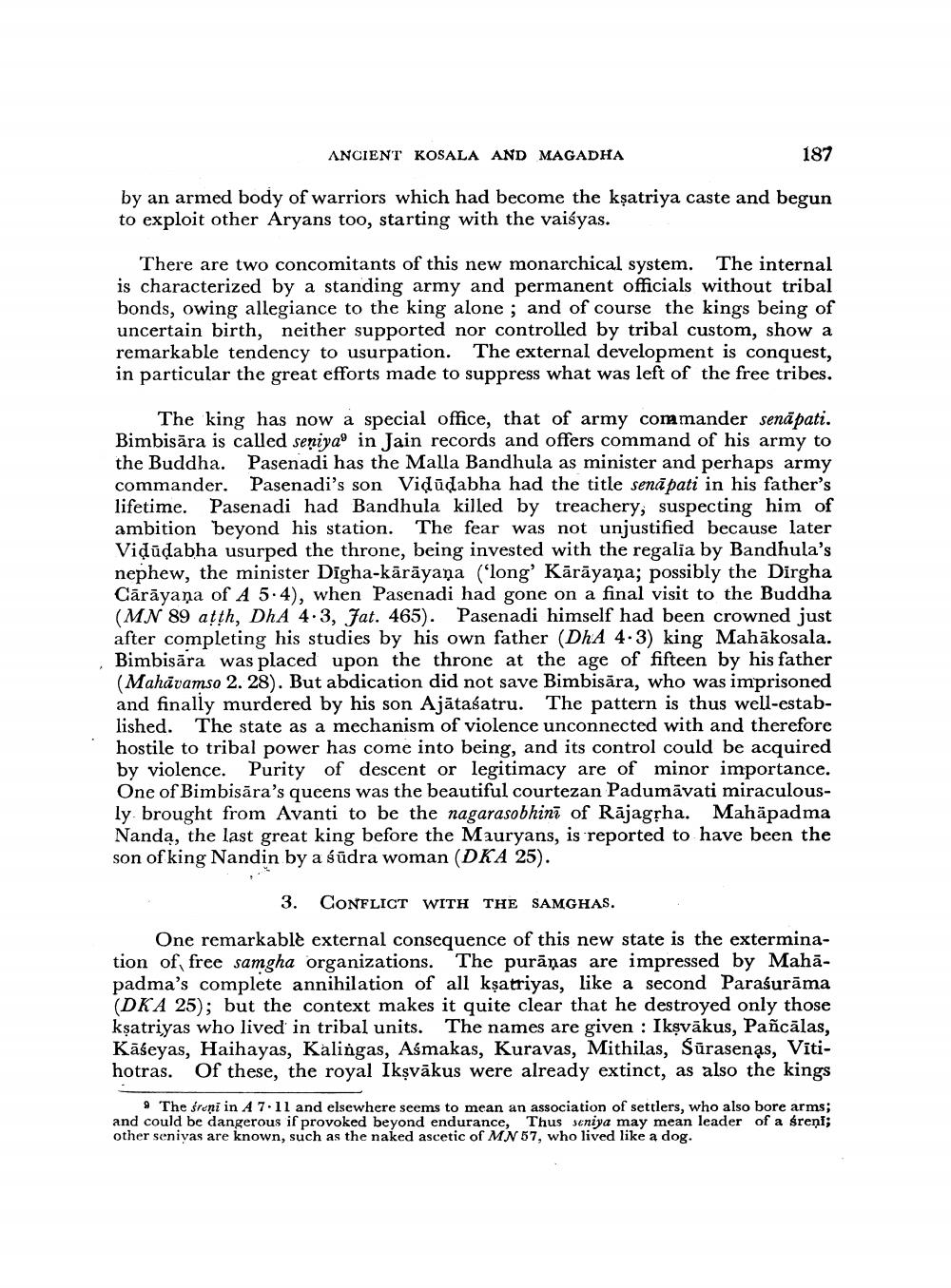Book Title: Ancient Kosala And Mmagadha Author(s): Dharmanand Kosambi Publisher: D D Kosambi View full book textPage 8
________________ ANCIENT KOSALA AND MAGADHA 187 by an armed body of warriors which had become the ksatriya caste and begun to exploit other Aryans too, starting with the vaisyas. There are two concomitants of this new monarchical system. The internal is characterized by a standing army and permanent officials without tribal bonds, owing allegiance to the king alone ; and of course the kings being of uncertain birth, neither supported nor controlled by tribal custom, show a remarkable tendency to usurpation. The external development is conquest, in particular the great efforts made to suppress what was left of the free tribes. The king has now a special office, that of army commander senā pati. Bimbisāra is called seniya in Jain records and offers command of his army to the Buddha. Pasenadi has the Malla Bandhula as minister and perhaps army commander. Pasenadi's son Vidūdabha had the title senā pati in his father's lifetime. Pasenadi had Bandhula killed by treachery, suspecting him of ambition beyond his station. The fear was not unjustified because later Viļūdabha usurped the throne, being invested with the regalia by Bandhula's nephew, the minister Digha-kārāyaṇa ('long' Kārāyaṇa; possibly the Dirgha Cārāyaṇa of A 5.4), when Pasenadi had gone on a final visit to the Buddha (MN 89 atth, DhA 4.3, Jat. 465). Pasenadi himself had been crowned just after completing his studies by his own father (DhA 4.3) king Mahākosala. Bimbisāra was placed upon the throne at the age of fifteen by his father (Mahāvamso 2. 28). But abdication did not save Bimbisāra, who was imprisoned and finally murdered by his son Ajātasatru. The pattern is thus well-established. The state as a mechanism of violence unconnected with and therefore hostile to tribal power has come into being, and its control could be acquired by violence. Purity of descent or legitimacy are of minor importance. One of Bimbisāra's queens was the beautiful courtezan Padumāvati miraculously brought from Avanti to be the nagarasobhinī of Rājagpha. Mahäpadma Nanda, the last great king before the Mauryans, is reported to have been the son of king Nandin by a sūdra woman (DKA 25). 3. CONFLICT WITH THE SAMGHAS. One remarkable external consequence of this new state is the extermination of free samgha organizations. The purāņas are impressed by Mahāpadma's complete annihilation of all ksatriyas, like a second Paraśurāma (DKA 25); but the context makes it quite clear that he destroyed only those ksatriyas who lived in tribal units. The names are given : Ikşvākus, Pañcālas, Kāśeyas, Haihayas, Kalingas, Asmakas, Kuravas, Mithilas, Sūrasenas, Vitihotras. Of these, the royal Ikşvākus were already extinct, as also the kings The śreni in A 7.11 and elsewhere seems to mean an association of settlers, who also bore arms; and could be dangerous if provoked beyond endurance, Thus seniya may mean leader of a sreņi; other senivas are known, such as the naked ascetic of MN 57, who lived like a dog.Page Navigation
1 ... 6 7 8 9 10 11 12 13 14 15 16 17 18 19 20 21 22 23 24 25 26 27 28 29 30 31 32 33 34
